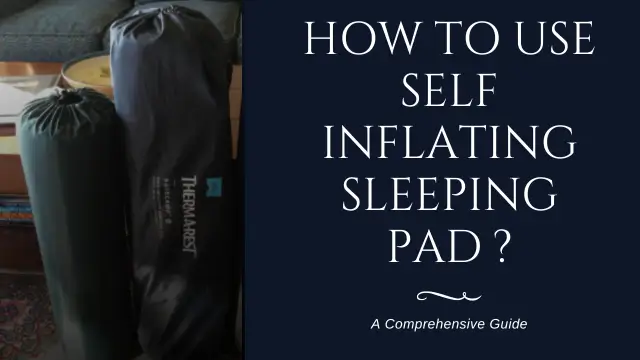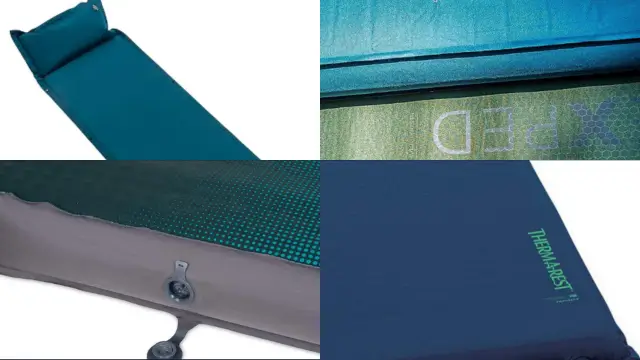Mastering Self-Inflating Sleeping Pad Usage: Tips and Techniques

Many campers and backpackers like self-inflating sleeping pads. They’re comfy, easy to use, and quick to set up, which is great when you’re tired from a day outdoors.
This article gives a simple guide on how to use self inflating sleeping pad. You’ll learn how to pick the right one, how to inflate and pack it, and how to store it the right way.
What is a Self-Inflating Sleeping Pad
A self-inflating sleeping pad is a camping and outdoor gear accessory designed to provide comfort and insulation for sleeping outdoors. These pads are constructed with a layer of open-cell foam enclosed in an air-tight shell.
The self-inflating feature allows the pad to expand and fill with air automatically when you open the valve. This combination of foam and air provides cushioning and insulation from the cold ground, making it more comfortable to sleep in a tent or outdoors.
Self-inflating sleeping pads are popular among campers and backpackers due to their convenience. They eliminate the need for manual inflation using a pump or blowing air into the pad, which can be time-consuming and tiring.
To use a self-inflating pad, you simply unroll it, open the valve, and let it inflate on its own. You can adjust the firmness of the pad by adding or releasing air using the valve.
These pads come in various sizes, thicknesses, and levels of insulation, allowing you to choose one that suits your camping needs and the conditions you expect to encounter.
They are particularly useful for providing a comfortable night’s sleep and insulation against the cold when camping in rugged or cold environments.
Choosing The Right Self Inflatable Sleeping Pad
Some top-rated self-inflating sleeping pad brands include Therm-a-Rest, NEMO, Exped, and Clostnature. These brands offer a range of options to cater to different preferences and budgets.
The choice of the best self-inflating sleeping pad suits your camping conditions and user needs, there are several key factors to consider:

- Insulation and R-Value: The R-value indicates the pad’s thermal insulation. For colder conditions, choose a pad with a higher R-value. An R-value of 4.0 or higher is suitable for winter camping, while 3.0 to 4.0 is good for 3-season use. For summer, an R-value of 1.0 to 2.0 is adequate.
- Pad Thickness: The thickness of the pad can affect comfort. Thicker pads are comfier but might take up more space. Consider your comfort preferences and how much space you have in your camping gear.
- Size and Weight: Ensure the sleeping pad fits your tent and is lightweight enough for your backpacking needs. Ultralight pads are ideal for backpackers, while car campers may prioritize comfort over weight.
- Inflation Method: Self-inflating sleeping pads are convenient as they partially inflate on their own and require minimal additional effort. However, some users prefer manual inflating pads for finer control over firmness.
- Durability: Check the material and build quality of the pad. Look for durable materials that can withstand rough terrain.
- Sleeping Position: Consider whether you’re a side sleeper, back sleeper, or stomach sleeper. Some pads are designed with specific sleep positions in mind for added comfort.
- Price: Consider your budget and find choices that fit it. Keep in mind that investing in a higher-quality sleeping pad can provide better comfort and longevity.
When choosing a self-inflating sleeping pad, it’s essential to consider your specific camping conditions, personal comfort preferences, and budget to make an informed decision.
How to Use a Self Inflating Sleeping Pad
- Unroll the sleeping pad: Begin by unrolling your self-inflating sleeping pad in your tent on a flat surface. Find the valve where you inflate it.
- Open the Valve to Allow the sleeping pad to self-inflate: Open the inflation valve by turning it counterclockwise. This lets air to flow inside the pad.
- Wait for Self-Inflation: Many self-inflating sleeping pads will start to self-inflate as soon as you open the valve. It can take anywhere from 5 minutes to half an hour for the pad to fully inflate, depending on the brand and model.
- Close the Valve: Once the sleeping pad has inflated to your desired firmness, close the valve by turning it clockwise to seal the air inside the pad.
- Check the Pressure: Lay on the sleeping pad to check the pressure for comfort. If you find it too firm, proceed to the next step to release a little air. If it’s too soft, you can add more air later.
- Adjust Firmness (Optional): To achieve softer support, open the valve slightly and gently bleed a little air out. For firmer support, open the valve and inflate the sleeping pad manually by blowing air into it.
How to Packing a Self Inflating Sleeping Pad
- Prepare for Packing: To prepare the sleeping pad for packing, start by opening the valve from the foot end. This step is crucial for efficient deflation.
- Deflate the sleeping pad: Fold the sleeping pad up several times while kneeling on it. This will force most of the air out through the open valve. Continue this process until most of the air has been expelled.
- Roll Up the sleeping pad: Unfold the sleeping pad, and starting at the foot end, roll it up. As you roll, push any remaining air toward the valve.
- Release Any Remaining Air: When you get close to the head of the sleeping pad, open the valve to let out any remaining air, and then continue rolling.
- Close the Valve: Once the sleeping pad is rolled up, close the valve tightly to prevent air from re-entering.
- Pack the sleeping pad: Pack your rolled-up sleeping pad into a stuff sack or a dry sack to protect it from abrasion during transport.
Tips for Maintenance and Cleaning
To clean and maintain self-inflating sleeping pads, follow these tips:
- Wipe Down: Clean the surface of your pad with a damp cloth using mild, non-detergent soap. Ensure you keep water away from the valves and keep them closed during cleaning.
- Avoid Machine Washing: Do not machine wash or dry your self-inflating sleeping pad. It can damage the pad’s internal components and valves. Read about: How to Wash a Tent in The Washing Machine
- Air Dry: After cleaning, air dry your pad by laying it flat or hanging it on a clothesline with the valves open. Avoid direct sunlight, as prolonged exposure can damage the materials.
- Storage: Ideally, store your sleeping pad unrolled with the valves open. This helps the foam self-inflate quickly when you use it next. You can store it under the bed, behind the couch, or standing up in a cupboard. Avoid storing it damp to prevent mold and mildew formation.
- Regular Maintenance: Periodic cleaning is recommended to prevent the buildup of dirt, oils, and other materials on your sleeping pad. Cleaning can help prolong its lifespan.
Benefits of a Self Inflating Sleeping Pad
Self-inflating sleeping pads offer several benefits for campers and outdoor enthusiasts:
- Energy Efficiency: One of the primary advantages of self-inflating sleeping pads is their ability to self-inflate, which saves campers energy, especially after a long day of outdoor activities. Unlike manually inflating air pads, you don’t need to exert effort or carry a pump to inflate them.
- Reliability and Durability: These pads have a lower chance of failure compared to other types of sleeping pads. The combination of open-cell foam and air insulation provides a reliable and durable sleeping surface. They are less prone to punctures and damage.
- Low Maintenance: Self-inflating sleeping pads require minimal maintenance. You don’t need to worry about inflating them manually or dealing with complicated setup procedures. Simply unroll the pad, open the valve, and it will self-inflate to the desired firmness.
- Comfort: These pads offer a comfortable sleeping surface, providing both cushioning and insulation from the cold ground. The foam inside the pad conforms to your body shape, enhancing overall comfort during sleep.
- Portability: Self-inflating sleeping pads are relatively lightweight and easy to transport. They can be rolled up and packed into a compact size, making them convenient for backpackers and campers who need to carry their gear over long distances.
Conclusion:
Self-inflating sleeping pads offer a simple solution for comfy outdoor sleep, ideal for any camper or backpacker.
Using one is a breeze: just unroll it, open the valve, and let it inflate. Adjust its firmness to your liking, then close the valve for a restful sleep.
Packing it up is just as straightforward. Open the valve, fold it a few times to squeeze out the air, roll it up from the bottom, and then seal the valve.
If possible, try to store it unrolled and inflated for quicker setup next time.
Why not give a self-inflating sleeping pad a shot for your next outdoor adventure? There’s a variety to fit your preferences and budget. Dive in and discover a new level of camping comfort!
You may also like:
How To Stop Slipping Off Sleeping Pad






